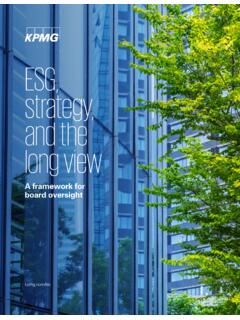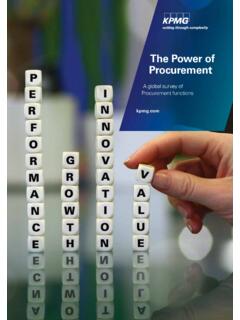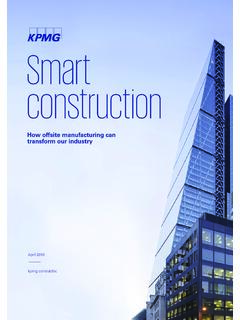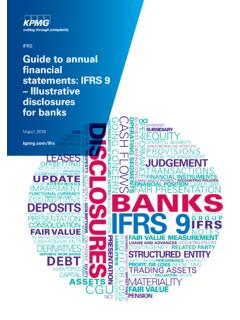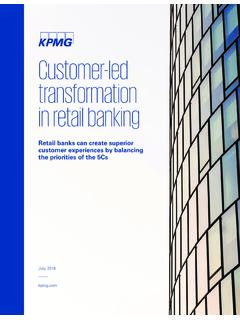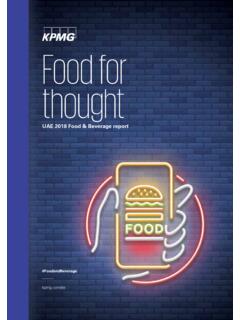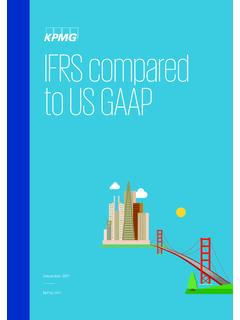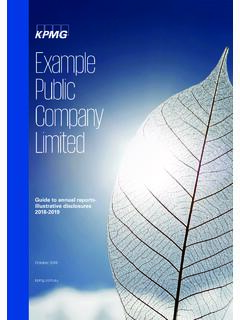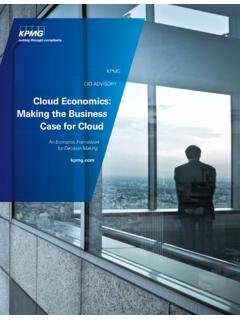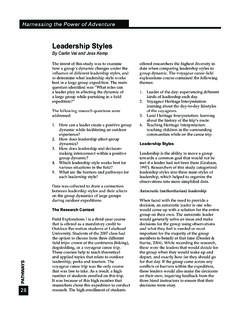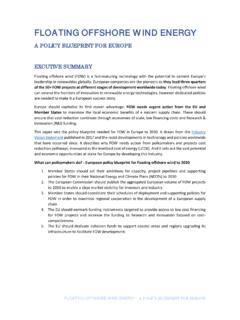Transcription of Medical devices 2030 - assets.kpmg
1 Global Strategy GroupKPMG InternationalMedical devices 2030 Making a power play to avoid the commodity trapThriving on disruption seriesWhile the outlook for Medical device companies appears positive, unsustainable healthcare costs and new competitive forces threaten to alter the future industry landscape. If today s manufacturers fail to stake their claim in the evolving value chain, they risk being caught in the middle and becoming commoditized. Staying ahead means offering value beyond the device and solving healthcare s problems rather than contributing to van den Heuvel KPMG in the USAnuj KapadiaKPMG in the USChris StirlingKPMG in the UKJia Zhou KPMG in ChinaThe days of simply manufacturing a device, and selling it to healthcare providers via distributors, have long vanished.
2 Value is the new byword for success, prevention the preferred clinical outcome, and intelligence the new competitive advantage. In this paper we discuss the pathway to success in 2030 for Medical device companies, following a three-pronged strategy: Reinvent Medical device manufacturers should take a closer look at their existing organizations and reinvent their traditional business and operating models to adapt to the future, by: integrating intelligence into their portfolios and offerings, to positively influence the care journey and connect with customers, patients and consumers delivering services beyond the device, and intelligence beyond these services a true shift from cost to smart value investing in enabling technology making the right choices to support a wide range of parallel business models tailored by segment to customers, patients and consumers (prospective patients)
3 And, ultimately, the financial ambition for the is equally important to prepare for the future by considering an outside-in 2030, the external environment will be extremely dynamic and Medical device companies need to reposition themselves in the newly envisaged competitive landscape, to cope with tumultuous forces from: new entrants, including competitors from unrelated industries new technologies, as technological innovation will continue to outpace clinical innovation new markets, as developing countries continue their high growth traditional Medical device value chain will rapidly evolve, and by 2030 companieswill take on significantly different roles.
4 Following their reinvention and repositioning, Medical device companies will need to reconfigure their respective value chains and define their place therein. Multiple value chain configurations will exist, requiring companies to make fundamental strategic choices. As somewhat evidenced today, manufacturers will continue to link themselves directly with patients and consumers, or combine with providers or even payers through vertical integration. Value chain reconfiguration choices will not be straightforward, and are likely to differ by company segment (device area, business unit, geography). This will be further complicated by the fact that the value chain itself will be dynamically evolving, as a result of other companies attempting to reconfigure and meet their strategic aims.
5 The right choices, however, will create significant value for the end user and help the company avoid a future of commoditization. Industry executives need to challenge conventional thinking, and reimagine the roles their companies will play in 2030. Accordingly, they will need to reconfigure today s organization to shift from being a participant in the value chain to being a solution provider for sustainable healthcare costs. Reinvent, reposition, reconfigure! Medical devices in 2030 being part of the solution2 Medical devices 2030 2018 KPMG International Cooperative ( KPMG International ). KPMG International provides no client services and is a Swiss entity with which the independent member firms of the KPMG network are affiliated.
6 All rights Medical device sales forecast to 20302 Revenues (US$ billion)80060040020002015371483617 CAGR Medical device industry is poised for steady growth, with global annual sales forecast to rise by over 5 percent a year and reach nearly US$800 billion by 20301. These projections reflect increasing demand for innovative new devices (like wearables) and services (like health data), as lifestyle diseases become more prevalent, and economic development unlocks the huge potential in emerging markets particularly China and India. Despite these apparently attractive prospects, a shadow hangs over the sector in the form of a relentless downward pressure on pricing.
7 Governments around the world are desperately trying to reduce the cost of healthcare especially in the most expensive part of the system: hospitals. They want to pay less for Medical devices and see proof of greater value in terms of better patient outcomes. Responsibility for many purchasing decisions has already moved from clinical to economic buyers. Short-term respites like the 2-year US excise tax moratorium on Medical devices notwithstanding, pricing appears to be going in one direction only down. Further uncertainty lies ahead, with the new European Medical Device Regulation in 2020 and regulations in China that are designed to spark local developments present a quandary for Medical device companies that have historically concentrated on manufacturing and research and development (R&D), but are now seeing healthcare budget restrictions and new reimbursement regimes continue to snip away at margins.
8 On top of this, new players some from entirely different industries are disrupting the sector by harnessing data to take ownership of customers, patients and consumers. In this volatile new marketplace, today s device players are in serious risk of being stuck in the middle of the value chain, as mere commodity 't get stuck in the middleUnbearable pressures disrupt the status quo 3 Medical devices 2030 2018 KPMG International Cooperative ( KPMG International ). KPMG International provides no client services and is a Swiss entity with which the independent member firms of the KPMG network are affiliated. All rights evolving value chainTraditionally, Medical device companies have delivered value primarily through manufacturing and selling their products.
9 But as pressures on the healthcare system mount, there are foundational shifts in the care delivery model, and as a result, the industry value chain is up for a drastic overhaul. In the new normal, companies will need to step out of their conventional manufacturing role. Services and data intelligence will need to be integrated with products to offer holistic solutions, requiring a power play across the value chain strengthening existing business-to-business (B2B) plays and creating new ones, while introducing business-to-consumer (B2C) plays. These power plays will likely include a continuous slew of deal activities mergers and acquisitions (M&A), strategic alliances and partnerships.
10 Medical device companies will ultimately seek to play a larger role in the value chain and get closer to customers, patients and consumers. Done right, this will not only add new revenue streams for them, but also contribute to shorter, cheaper, and fewer hospital visits and thus lower healthcare costs. Making a power play across the Medical device value chain of the future 4 Medical devices 2030 2018 KPMG International Cooperative ( KPMG International ). KPMG International provides no client services and is a Swiss entity with which the independent member firms of the KPMG network are affiliated. All rights 2030 the leading Medical device players will be those that play an active role in delivering value by connecting with customers, patients and consumers (end users).
